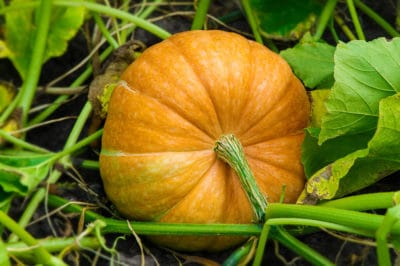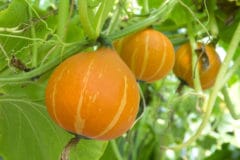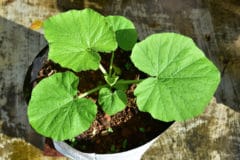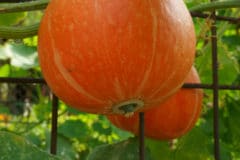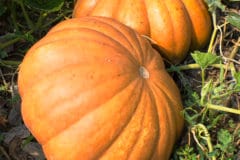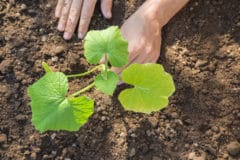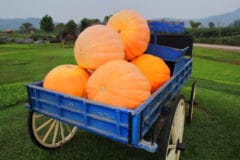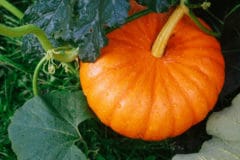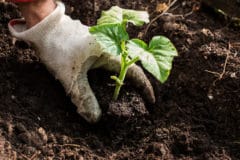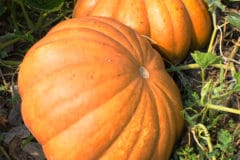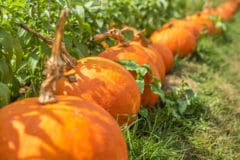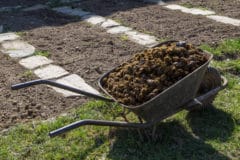Choosing the Best Pumpkin to Grow
There are so many different varieties of pumpkins that the only thing limiting a gardener is lack of imagination. Although all types of this hardy vegetable are edible, some people prefer to grow ornamental ones while others want to win the blue ribbon at the fair with a giant one.
Whichever types you decide to raise, make sure the seeds you have are clean and free of mold or blemishes. A healthy seed means a healthy plant, and compromising on seeds is never a good idea.
Preparing the Land to Plant Pumpkins
Pumpkins grow easily in nearly any type of soil, which is one reason why it is such a favorite vegetable in most gardens. If the ground in your garden is of a clay-like consistency, you may want to add peat moss or compost. Sandy soil would benefit from the addition of a thick mulch like bark or straw. As a rule of thumb, add 2-3 inches of fully composted material and work it into the ground before planting.
How to Plant the Pumpkins
After working the compost into the soil, there are several ways to plant pumpkins. One of the most common farming methods is to create mounds or hills. Hills are better for small garden spaces. If you have a large garden area or are growing pumpkins on a large scale, rows tend to work better.
Whether planting in hills or rows, plant only seeds that are clear and free of any blemishes or mold. Also, check the seed packet for an expiration date. Although seeds stay well preserved and can often be planted several years after packaging, you should use the freshest seeds possible to guarantee healthy plants.
Proper Spacing of Plants
If planting in hills, each one should be approximately 6 feet apart. In each mound, place six pumpkin seeds about an inch apart from one another. Once the plants have developed two sets of leaves, pull the weakest ones and leave 3-4 of the sturdiest seedlings to form.
For row planting, the space between rows should be at least 6 feet, and plants should be thinned to one hardy plant every 18 inches.
Tip: Be aware that pumpkin vines spread quickly and can spread over 20 feet from the plant. If you do not have enough land to allow the vines to spread, consider growing pumpkins in large containers instead.
Thinning Young Seedlings
Pumpkins do not like to be crowded, as they are large vining plants that need a lot of room to spread out and grow. To provide a happy growing environment, you need to thin the seedlings once they have two sets of leaves.
When thinning, be sure to pick the healthiest, greenest looking plants to continue growing. Pull out any that do not have two sets of leaves or that appear yellowish and smaller than the rest. Doing so prevents overcrowding and allows the strongest plants to thrive.
How Long from Planting to Harvest?
Pumpkins require a long growing season, anywhere from 80 to 125 days depending on the variety. If you live in a geographical area with a short growing season, be sure to pick an early-ripening kind of pumpkin to ensure a good harvest.
Tip: Be sure to check the packet of pumpkin seeds to find out how long the growing season for that particular kind is. Some pumpkin mature in as few as 80 days, while others take as long as 125 or more to reach their adult size. The length of time from planting to harvest gives you an idea of whether you can plant directly in the ground or need to start the seeds indoors.
Starting Seeds Indoors
If you want to start your pumpkin seeds indoors to grow a type of pumpkin that takes longer to mature, you can start them approximately four weeks before the last frost date. Indoor planting gives the plants ample time to germinate and form leaves before planting outdoors.
Plant your pumpkin seeds in small peat pots filled with potting soil. Water to moisten and place in a sunny location. Be sure to keep the soil moist but not saturated. Seeds germinate in about a week and should be ready to plant within about four weeks.
Tip: You can also purchase ready-to-plant seedlings in a local nursery or garden store.
What Do Pumpkins Need to Thrive?
Like all plants, pumpkins need ample sunlight, nutrition in the form of fertilizer, and plenty of water. Follow these tips to provide the best growing environment possible:
- Plant in a sunny location with 6-10 hours of direct sun.
- Fertilizer every 3 weeks.
- Water frequently to keep the ground moist.
- Provide room for vines to spread.
- Protect the plants from pests and weeds.
Fertilizing Pumpkin Plants
There are both man-made fertilizers and organic ones; which you choose depends on whether you are growing certified organic pumpkin or not. Either method you use, be sure they contain nitrogen, phosphorous, and potassium.
Commercial fertilizers come pre-mixed with the correct ratios of the three elements needed. Typically a 5-10-5 rate is ample for healthy pumpkin plants. Apply the fertilizer precisely as directed on the packaging and your plants will remain strong and healthy.
Organic fertilizers are less exact unless you purchase a commercially produced organic fertilizer . If not, you can start with working manure into the soil at planting, add a thin layer of wood ash after the seedlings have formed, and follow it up by mulching with a thick layer of grass clippings.
Weed Control
Weeds are the scourge of any gardener, regardless of the plants being grown. Be sure to control weeds in the pumpkin patch by applying a weed killer or covering the plants with a heavy layer of mulch. Also, be prepared to weed with a hoe and by hand until the pumpkin vines are large enough to smother any remaining weeds.
Problem Pests for Pumpkins
Although pumpkins tend to grow very well with few, if any, problems, gardeners do need to be on the lookout for common pests such as pumpkin beetles or aphids. These pesky insects can quickly devour your pumpkin leaves and flowers, which prevents a bountiful harvest.
Ladybugs eat aphids, so using integrated pest management for these insects can be successful. However, if you have pumpkin beetles or both aphids and beetles, you will need an insecticidal soap to get rid of them. Watch plants carefully for emerging bugs, as the quicker the treatment, the more successful your harvest.
Developing Blossoms
As the pumpkin plants grow and the vines begin to spread, you will notice yellow flowers growing. There are both male and female flowers, and both are needed to form fruit. For that reason, it is imperative not to pick or damage the flowers. Once pollination has occurred, the plants will develop small green pumpkins.
After the green pumpkins form, it is almost as if you can sit back and watch them grow. During this time, the plants need extra watering and another application of fertilizer. It takes an incredible amount of energy and nutrition for pumpkins to grow to adulthood.
Knowing when to Harvest Pumpkins
Watching the growing process of pumpkins is a fascinating endeavor. However, nothing beats the satisfaction of seeing the green pumpkins begin to turn orange as harvest time approaches. However, just because they are becoming the proper color does not mean it is time to harvest!
Although turning orange does indicate harvest time is nearing, there are also other signs to notice.
- Pumpkin vines begin to die off.
- Stems start to dry and shrivel.
- The shell od the pumpkin is uniformly hard.
How to Harvest Pumpkins
Harvesting pumpkins is likely the easiest part of the entire pumpkin planting process. Once the skins are fully colored, and the rind is hard, they are ready. Just cut the stems with a sharp knife. Be sure to leave enough of the pumpkin stem to grab the pumpkin with your hand.
It is also important to remember that pumpkins do bruise despite their hard shell. When moving or storing them, be sure to handle them carefully!
Planting pumpkins is one of the most satisfying things for a gardener to do. Not only are the plants easy to plant and uncomplicated to grow, but the result is also a beautiful orange, white or yellow orb suitable for eating or carving into a Jack O’Lantern.
